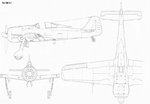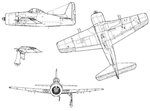Stephan Wilkinson
Airman
- 27
- Oct 20, 2007
For a Bearcat cover story I'm doing for Aviation History magazine, for which I frequently write:
Legend has it that the F8F Bearcat was "inspired" by the Focke-Wulf FW-190, after two Grumman pilots flew a captured -190 at the RAE, in England, in September 1943. Corky Meyer perpetuates this account in his book (with Steve Ginter), "Bearcat."
The problem is, LeRoy Grumman is on record as having sent Chief Engineer William Schwendler a memo on 28 July 1943, almost two months before anybody from Grumman ever even saw a Focke-Wulf, that outlined all of the basic parameters of what became the Bearcat, which seems to me to mean that the -190 might well have encouraged Grumman that it was on the right track but in no way inspired the design of Grumman G58, which quickly became the F8F.
Any comments?
The obvious question is, how could Meyer have gotten it wrong? My surmise is that at the time when all this was going on, Meyer was a 24-year-old junior test pilot (he was not one of the two Grumman pilots who went to England to fly the Focke-Wulf) with six month of Grumman employment and little real access to senior management, and that he perhaps bought into company rumor and gossip at the time, but I have no way of knowing that.
Is there anybody out there who can either corroborate what I'm guessing, or set me straight?
Legend has it that the F8F Bearcat was "inspired" by the Focke-Wulf FW-190, after two Grumman pilots flew a captured -190 at the RAE, in England, in September 1943. Corky Meyer perpetuates this account in his book (with Steve Ginter), "Bearcat."
The problem is, LeRoy Grumman is on record as having sent Chief Engineer William Schwendler a memo on 28 July 1943, almost two months before anybody from Grumman ever even saw a Focke-Wulf, that outlined all of the basic parameters of what became the Bearcat, which seems to me to mean that the -190 might well have encouraged Grumman that it was on the right track but in no way inspired the design of Grumman G58, which quickly became the F8F.
Any comments?
The obvious question is, how could Meyer have gotten it wrong? My surmise is that at the time when all this was going on, Meyer was a 24-year-old junior test pilot (he was not one of the two Grumman pilots who went to England to fly the Focke-Wulf) with six month of Grumman employment and little real access to senior management, and that he perhaps bought into company rumor and gossip at the time, but I have no way of knowing that.
Is there anybody out there who can either corroborate what I'm guessing, or set me straight?


